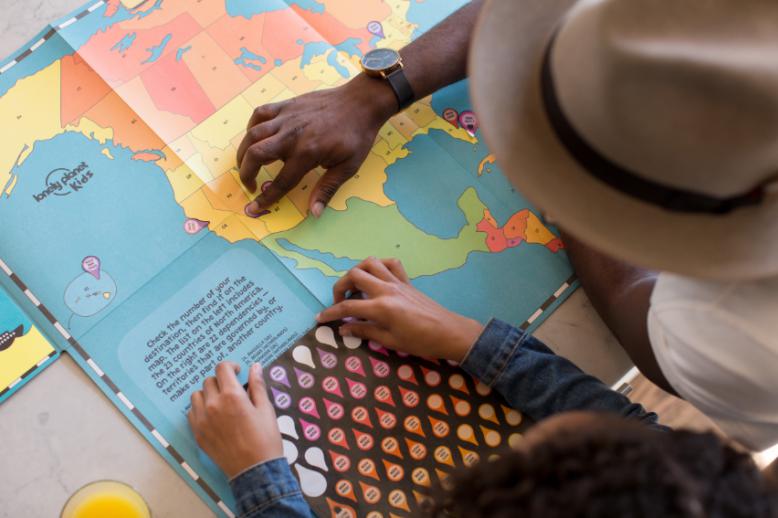 looking at a map" width="" height="" />
looking at a map" width="" height="" /> looking at a map" width="" height="" />
looking at a map" width="" height="" />
Our brain is an image processor, not a word processor (Kouyoumdjian, 2012). Moreover, if our students have been raised in this media-centered society, the pedagogical use of visual aids to engage them is a must.
There are different ways to enrich a lesson using visual aids. If we want retention of information, these six ways are sure to do the trick. The acronym V.I.S.U.A.L. will help you remember these six ideas.
Table of Contents:
Since our brain is designed to remember pictures, visuals give concrete information. You are 65 percent more likely to remember something with a visual than if it was a vocabulary word alone (Medina, 2018).
Just the other day, I was trying to explain the definition of “bellow.” How can one explain this word except to show it in action? It can be acted out by shouting in a deep voice, or one can show a picture of a boss shouting an order to an idle employee. This clarifies the meaning and locks it into memory. The students can later draw their own pictures along with the definition since the brain will retain words that are read and seen. (Side note: Have them say the word and act it out, and you have nearly doubled their retention.)
Grammar is an area that can be quite dry if one just teaches the rules. Visual aids not only help in aiding understanding, but also assist students in remembering a rule with a picture in mind. For example, clauses always have a subject and predicate. This can be helpful knowledge when one is learning about dependent and independent clauses. To illustrate this rule, I draw the head of Santa Claus and put an “S” earring on one ear and a “P” earring on the other. We then touch our ear, saying “S” and “P” when we hear the word clause signifying that clauses always have subject and predicates. They never forget it with this visuals.
If you are about to embark on a new topic or theme in the class, have the students go on a virtual adventure or field trip. The Smithsonian has a large index of tours that would spark your students’ interests.
Another way is to give the students a picture of a problem to solve. The students could even make a visual representation of the problem. For example, “A rabbit is stuck at the bottom of a five-foot hole. Each day he climbs up two feet and slides back down one. What day will he reach the top to escape?” They could draw this out or they could view it and then write it out and solve it.
Finally, as a writing prompt, I like to show my students a Life magazine-type picture at the beginning of class. The goal is to think about what was happening in the scene. Who are these people and what are they doing? They would then write about this for a five minute bell-ringer.
Thinking maps are powerful visual learning tools that can help us better organize our ideas or map out a process. There are eight kinds, ranging from bubble maps to flow maps. Using a flow map, for example, students can sequence the events of a story; mapping it out allows the brain to see the flow of events more effectively before writing about or discussing the story. Mapping through drawing combines words and pictures in a formatted way which allows the thinking to be processed out, helping the complex become understandable.
Picturing a problem can be a helpful tool in aiding students to come up with a solution. Word problems allow for the practical application of math and therefore are a great vehicle to utilize visuals. This works great in learning money, for example, “Jose has two dimes, five nickels, and ten pennies. How much money does he have?” Drawing the actual scenario can give students a concrete visual to solve this problem. Also, if there is a misunderstanding of the problem, teachers can quickly identify where the student may be struggling in their processing.
In all classrooms, but especially for ELL’s, visual supports are beneficial examples of scaffolding. When the learning is scaffolded students are building on prior learning, and it presents ways for students to build on a success before they learn something new. This is vital for ELL students. One example of a visual scaffold is an anchor chart. I like my walls to teach when I am not teaching. This means we need to be intentional with our wall space. When used with fidelity, anchor charts engage and support instruction because students can visually review a process and be reminded of a concept already taught. The benefit of an anchor chart is that it can be displayed and referenced as needed.
With these V.I.S.U.A.L. ideas you can transform your classroom into a vibrant learning lab. The effective use of visuals can increase retention and enhance the learning process. It is also sure to make learning more fun and lively.
References:
Kouyoumdjian Haig Ph.D. Learning Through Visuals. Retrieved from
Medina, John. (2018). Brain Rule Breakdown. Retrieved from http://www.brainrules.net/vision
Dr. Stephanie Knight is an experienced 7th and 8th grade English language arts educator. She taught in Title One schools for eight years—helping them grow from underperforming to excelling—and then in an independent school for four years. Knight is now is part of Grand Canyon University’s adjunct faculty where she teaches graduate level education and reading courses.
The views and opinions expressed in this article are those of the author’s and do not necessarily reflect the official policy or position of Grand Canyon University. Any sources cited were accurate as of the publish date.